Interview: Jonathan Worth, Photographer and Open Source Online Learning Pioneer
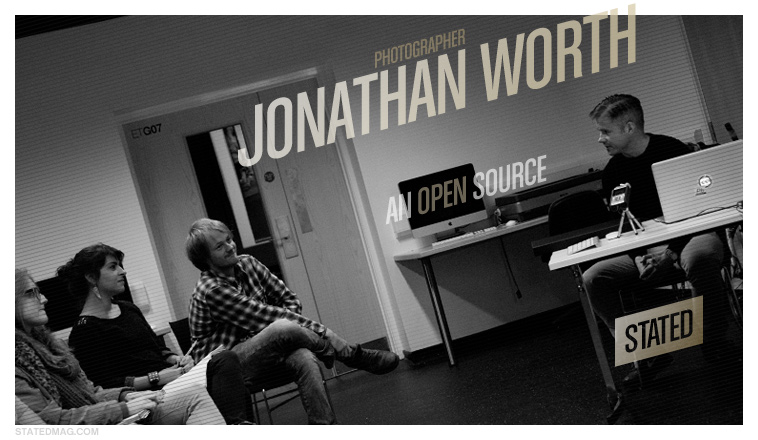 |
||||||||
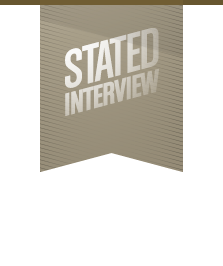 |
INTERVIEW WITH PHOTOGRAPHER JONATHAN WORTHBy Thomas V. Hartmann, Photography Editor (All photos of Jonathan Worth by Matt Johnston) It’s hard to believe, but the online course will soon celebrate its 20th birthday. In web years, that makes it pretty ancient—the same age as the graphical browser or, in equivalent normal years, the television and the ballpoint pen.* The familiarity—ubiquity, even—of online courses doesn’t mean, however, that we have exhausted all possibilities for delivering education via the web or that we’ve seen all there is to see of the web’s potential to transform how we learn or to cause seismic rumblings underneath education-with-a-capital-e. Quite the contrary, in fact. 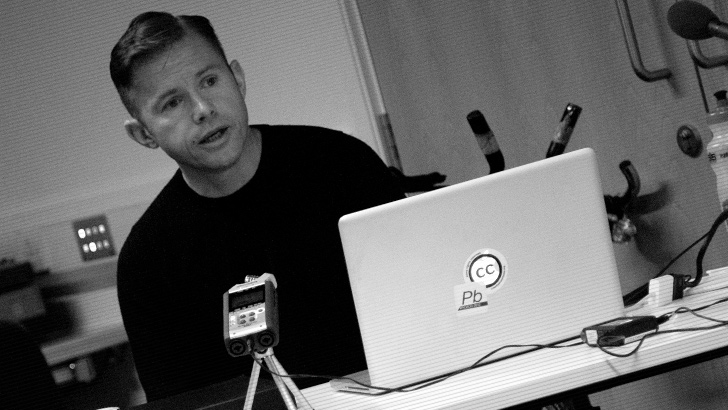
Because they promise to provide high-quality education to basically anyone who wants it, MOOCs represent both a threat and an opportunity for established purveyors of higher ed. Some commentators foreground MOOCs’ disruptive characteristics, and it’s common to the point of cliché to hear MOOCs described as a rising tidal wave that’s about to wash away the academy’s ivory towers. At the same time, however, more and more elite universities, for example, Harvard, Princeton, Caltech, Johns Hopkins, and Berkley, are partnering with MOOC-centric startups like Coursera, Udacity, and others to make super courses a part of their offerings. 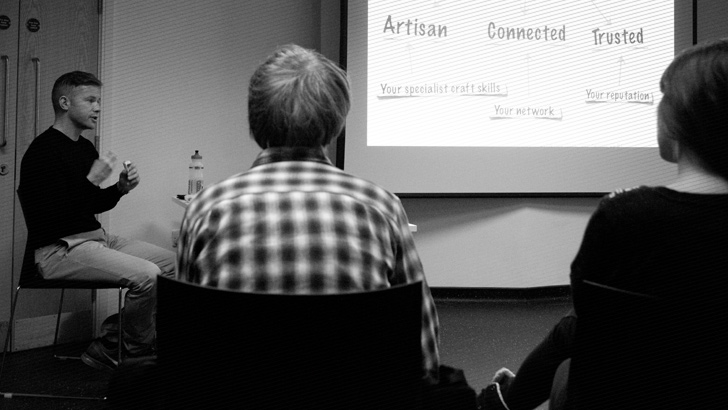 |
|||||||
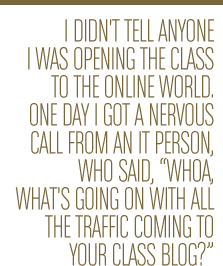 |
||||||||
|
In a recent article in The Guardian, education consultant Mike Boxall poses some intriguing questions about MOOCs and their possible impact on academe: “When knowledge and educational content become free commodities, how will universities justify the value of their fees? When degree-level programmes and supporting services become available on-demand, whenever and however students wish to access them, why should courses be tied to academic timetables based on the ecclesiastical calendar? And when the elements of higher education—content, courses, support, assessments, awards—are all separately available from world-class providers, what will be the role of the university?” As Boxall notes, however, it will be some time before the big picture becomes clear. In the meantime, there are fundamental, practical questions that need answering. For instance, there are plenty of examples of how MOOCs have been deployed successfully to serve learners in areas like business or technology or other areas of the sciences, but what role might they play in disciplines that lend themselves less well to distance learning—in subjects in the arts, for instance, like painting or photography, where students and educators alike seem to generally agree on the preference for and efficacy of more intimate learning environments in which the time-honored master-apprentice relationship can be fostered? Can a MOOC, in many ways the very antithesis of the time-tested model of arts education, be used to deliver worthwhile—or even extraordinary—education to student artists? |
||||||||
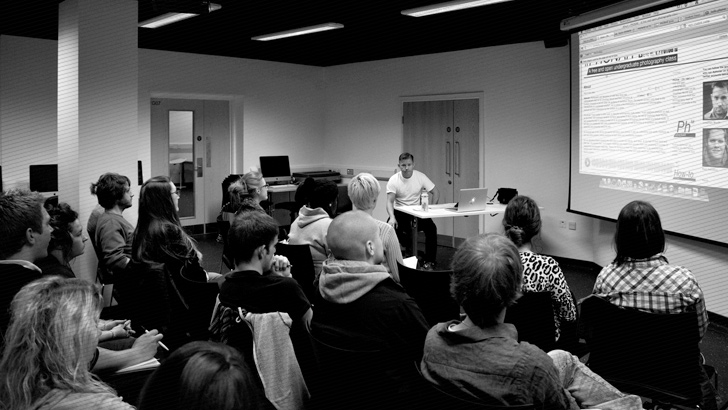 |
||||||||
|
Jonathan Worth, an accomplished editorial photographer and a professor of photography at the University of Coventry in the UK is proving the answer is a resounding “yes.” Worth is the principal architect and driving force behind two undergraduate photography courses at Coventry, “Picbod,” short for “Picturing the Body,” and “Phonar,” short for “Photography and Narrative.” Run as MOOCs, and with participants in one section cresting 20,000, Picbod and Phonar surely must be the largest photography classes ever taught. I spoke with Worth a few months back about how he conceived the courses, what his experience has been like leading them—which means facilitating tens of thousands of learners while at the same time handling commercial work—and how the combination of course content and the MOOC environment has enabled his students to make inroads to professional photography practice in ways that even Worth hadn’t thought possible. |
||||||||
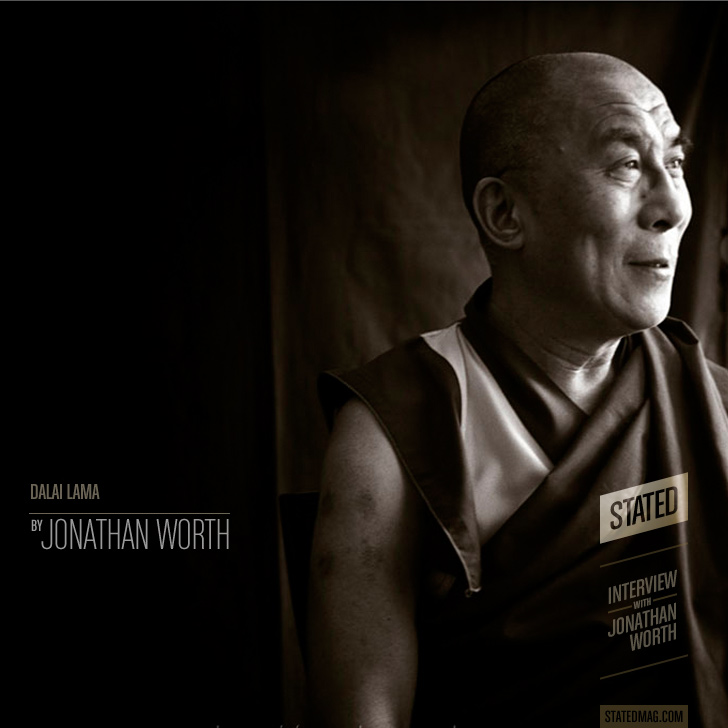 |
 |
|||||||
| (Dalai Lama) | (Alicia Keys) | |||||||
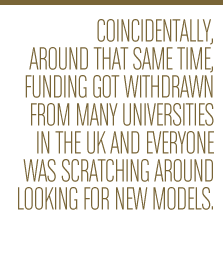 |
ASK FOR FORGIVENESS, NOT PERMISSIONstated: Thanks very much for speaking with us Jonathan. First, perhaps you can describe Phonar and Picbod and tell us a bit about how you came up with the concepts for them. JONATHAN WORTH: Kind of by accident, really. I guess it’s the best way to describe the birth of Picbod, which is short for “Picturing the Body.” It came to a point where it just seemed a really good solution to a bit of a problem. It was a brand new course, with no history of photography, it was the first year that it had gone through and the students were in their second year, and there were seven in the class. I’d been asked to come on and write and teach some classes, but the course hadn’t been advertised when it first opened—there was literally one advert in a local newspaper—and pretty much whoever came to the front door got in. There were seven students in the class. By the second year, they were asking questions, which I genuinely wanted to supply answers to. One of the things was, you know, they had seen the stuff that I’d done and that I work in London and New York, and they wanted to know how they could work in NY and work with the people I work with. I was trying to find a way to bring those people into their classroom. No one’s going to travel from America to the middle of England, so I was thinking, “How can I build relationships with these people and the class?” It seemed the most appropriate way was to open a class online, which some people read as giving it away for free, and free became a tag that people applied to it. What I did was allow people to look through the window on to the class. But I was new to education and really sort of finding my own way, and I didn’t know enough to be scared about what I was doing. So each time I wrote a lecture or wrote a class or put stuff out online, it was terrifying for me anyway, so it wasn’t that big of a deal, to just open it out online. I guess the worst that could happen was someone would say, “Well that’s rubbish,” or “Why are you bothering with that, you can’t do that properly?” But no one ever said that and all I got was support—support from photographers and people within the photography industry. Suddenly, everything I was worried about, everything I thought I might not be any good at, got better and better and the class got better and better and the students’ experience improved and suddenly the people they dreamed of meeting or working with were looking at their work. By the end of the 10-week class, one of the students, a second-year undergraduate student, had her classwork edited and put in a book by the creative head of a huge publishing house. He’d followed the class from Hong Kong where he was working because he was so into it and the students’ work. I hadn’t actually introduced him personally—he just sort of came along to the class. It had taken me two years to meet him when I left university. For me, that was it. I thought, this is valuable as part of an education program. Oh, I neglected to mention that I had done all this in secret. That potentially could have come back to bite me. I didn’t tell anyone that I was opening the class to the online world. One day I got a call, a nervous call, from an IT person, who said, “Whoa, whoa, whoa, what’s going on with all the traffic coming to your class blog?” I said, “Oh, I don’t know, I’ll look into that…” Shortly afterwards, I got another call asking, “Is there something going on with that blog, because you’re getting more traffic than the rest of the whole school?” At that point I had to sort of come clean and admit that it may have been something that I did.” Coincidentally, around that same time, funding got withdrawn from many universities in the UK and everyone was scratching around looking for new models. The class was an interesting new thing that was happening, and the university really got behind me doing it and encouraged me to do some more, so I was kind of saved. That’s the story of how “Picturing the Body,” the first class, was born. stated: I guess it goes to show that sometimes it’s better to apologize than to ask permission. How many participants have you had thus far? JONATHAN WORTH: You can play with those statistics, can’t you? But I thought you might ask. I don’t know what the visitors are for “Picturing the Body” right now, but “Phonar,” (“Photography and Narrative,”) which ran between September and December—and the whole point of that class is that it considers the photographer as publisher rather than supplier; I always thought of myself as a supplier; that’s my old business model—so Phonar was open and we had 21,755 visitors—that’s different people that came to the class—and 40,000 visits. I think one of the most interesting statistics is the average time people spend on the site. It’s around 5 minutes. I think we had about 10,900 visitors come to “Picturing the Body” last year, so it’s kind of snowballing, I think, as more classes run. In the past, there have been big gaps between open classes, as well, so it sort of drops away as people go elsewhere, but we’re opening out more classes and I think more people are doing it, so we’re hoping to retain some of those visitors, maybe introduce some new people to [the classes] as well. |
|||||||
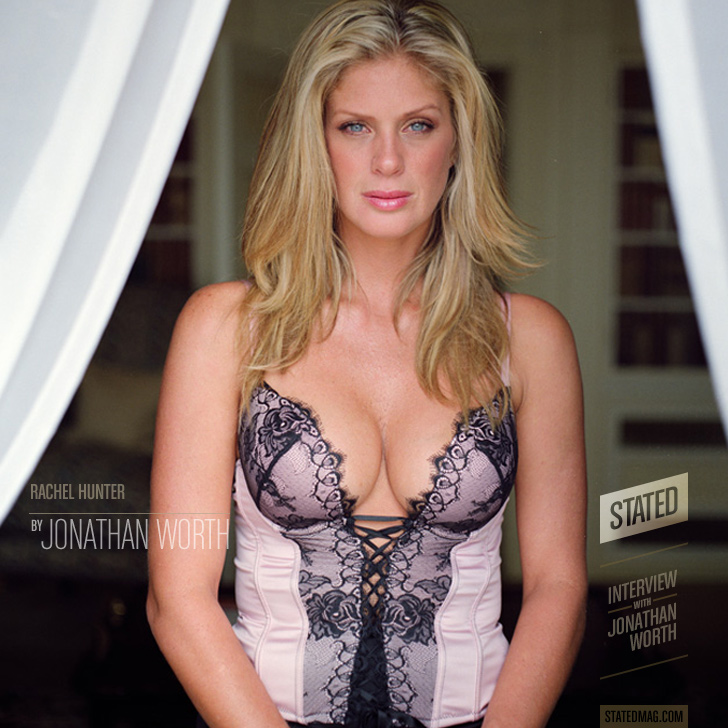 |
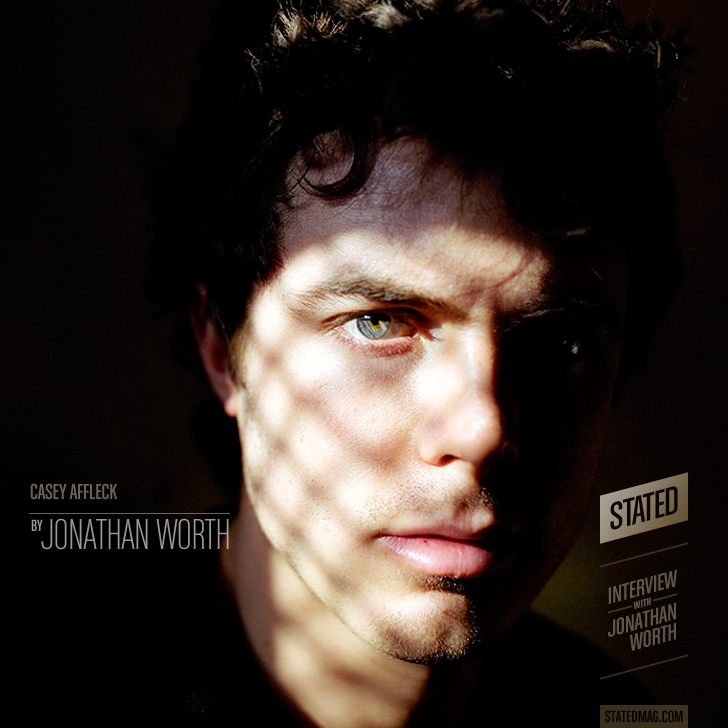 |
|||||||
| (Rachel Hunter) | (Casey Affleck) | |||||||
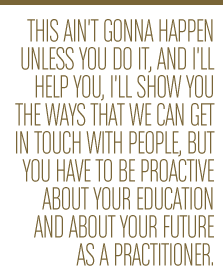 |
GETTING PROACTIVEstated: You recruited a pretty impressive roster of photographers to participate in these classes. Maybe you can tell us a bit how you went about approaching various people and what their feedback has been on being involved with the classes. JONATHAN WORTH: I ask the students, who would they love to hear from; who their favorite, most-inspiring photographic figure is. I ask for a contemporary figure as well—they have to be alive—and then if [the student] gets into the course, I say, “Within four weeks, I want you to tell me what this person thinks of your work.” So that’s their opening gambit. I say, “This is in your court. This ain’t gonna happen unless you do it, and I’ll support you, I’ll help you, I’ll show you the ways that we can navigate to get in touch with people, but you have to be proactive about your education and about your future as a practitioner.” So that’s their introduction to the course and certainly it’s their introduction to me. So, once they come in to the class, it’s pretty easy to say who really inspires you, who would you love to have here, and then we say, right, how are we going to get in touch with those people? You know it’s not difficult. People, especially early on, saw what was happening and they saw this platform with a bunch of people coming by and people came to get involved. I have no money to pay people, so everything was done on a trade-for-trade basis. I would say to [potential participants from the world of photography], if you come and give us a talk or if we do an interview over the internet, then I’ll make it in to a little film and then you’ll have that as well—a learning object, if you will, that you can embed on your website or do what you like with it, so we both get something out of it. I would retain a version, which would be openly available on the class. So, people weren’t coming because they were getting paid loads—they were coming because they understood what I wanted to do with the course and they wanted to be a part of it. But actually getting in touch [with well-known photographers], you know that’s not really very difficult. To be honest, at this point, this was something I would learn from the students; they taught me. They know how to navigate social media environments; they just don’t know that they know it. So, by asking them to “tell me what [the person you selected] thinks of your work,” I’m saying, “You live in these spaces—Facebook/Twitter/and elsewhere—you can navigate that network.” Lots of students would say, “Oh, they won’t want to speak to me,” or “They won’t even listen,” and I would stress that it’s about how you approach people, isn’t it? You wouldn’t walk into a bar and expect someone to come over and chat to you (unless you had sort of a very high opinion of yourself), but you might go over and talk to them, and the first thing you would do is smile, which is quite disarming, and then you’d perhaps find some common ground to talk about. If you really liked that person and knew about them then surely when you came to talk to them, you’d be informed in your conversation about them already, so you’d say, “Hey, I really love what you’re doing, blah blah blah,” or “Tell me about that great thing you did,” or perhaps you’d understand them enough to negotiate that relationship [in another way]. If you knew the person was into football, then perhaps you’d go across and talk about football, you know? It’s common sense, real-world stuff, it just happens in a different environment and students know how to do it. Once students understand this, then it’s like, wow. Suddenly I come back and one of them is going off to be an intern with Annie Leibovitz! How did that happen? You know, that just doesn’t happen to students that grow up in the middle of England in Coventry with no US contacts in photography, but suddenly it happened; it happened in the first class. stated: I guess that’s one of the most magical things about social media, that, through Twitter for example, you’re able to send a message to someone like Annie Leibovitz and that message is at least going to reach her, whereas if you send a letter or call on the phone there are so many gatekeepers, the message may never get through… JONATHAN WORTH: Absolutely, absolutely. One of the things I think is so interesting about all of those environments, Twitter in particular, is that a lot of us photographers have come to hate it because it because it’s changed our business model so fundamentally. But when you begin to consider it as something that can actually work for you, it becomes an incredibly powerful tool. You can actually assemble a conversation, you can aggregate a conversation that will only be taking place in your stream on your computer because all of those people are itemized, they’re all over the world only aggregated, brought together by you in one space that only you dictate the terms of, effectively. Let’s say for instance, you do a Twitter search on bananas, then everyone that’s talking about bananas is going to come in to that stream and it becomes a conversation, a conversation which you can overhear, a conversation which at any point you can jump into real-time and talk with all the other people who are into bananas, right there and right then. The same thing can be with Annie Leibovitz or it can be with any other [prominent figure]. Leveraging their skills at social media was something that we worked on with students. I think we’re talking about 2008…that was when we started to work out that the people who were really good about navigating social media spaces and who understood them were the students, and that this was an asset that they could trade on. Several of my students are now working for high-profile people. I can’t say who they’re working for, but one is working in Texas, three are in New York, one works for a painter in London, and one other works for a photographer in London, all are working for these people as their social media assistants. We had to sort of make up a title for what they’re doing. stated: The students who are participating in the courses at the highest level, they are registered University of Coventry Students, right? JONATHAN WORTH: Yeah, so anyone that’s sitting in the classroom has paid their fees and at the end of the course will get their degree, if they achieve it. Anyone that’s following online—the remote student is how I refer to them—gets all of the same information, they just don’t get the one-on-one tutorials at quite the same regularity. They are encouraged to engage real-time, and we’re trying to offer more and more stuff live and real-time because we find that we haven’t found any downside to it yet. I mean, when 40,000 people turned up last term, there wasn’t an increase at the loan store, you know? I didn’t have to find any extra chairs. [All of the remote students] just brought good stuff. None of them brought a queue of questions—well they did, but then they brought a community that also answered those questions and very often better than I could answer them. stated: In terms of offering constructive criticism, did you establish guidelines? How has that aspect of the courses developed? JONATHAN WORTH: A key part of the class… When the students come to the class, they’re given the option to do it openly or they can do it in a closed fashion. The closed fashion would be the traditional sort of behind-walls education, so if someone did choose that, then they would access a version of the class through the usual sort of routes that you do in university. But what I say is that if you’ve signed up to the openness then this is a big commitment from me—the class takes place over seven days and over multiple time zones—so I expect the same commitment from you. I get them to write up, effectively, an open learning agreement whereby they understand that what they’re dealing with, that rather than being someone who comes and pays for an education and expects to be taught, they are someone who’s considering themselves to be a potential supplier and someone who’s now beginning to think of themselves in terms of a brand, and so they all sign up to put an appropriate face on the openness of the class for each of them. One thing they agree is to feed the open class. If you don’t send any Christmas cards, so to speak, don’t moan when you don’t get any back. Each week we say we’re going to go around and look at everyone else’s work and we’re gonna put a line on everyone else’s work, even if it’s just one comment. I tell everyone in the class to look to one or two people who aren’t in the class and I want you to find someone else and I want you to introduce their work, the bit you like, to the rest of the class and bring them to the party. When you do that, then suddenly that kind of spreads out and you get this sort of compound good will and compound commenting and peer support. I encourage peer support rather than me having to get around to 32,000 people personally because I just can’t do that, you know? Eventually subgroups form around special topics or kinds of photography—let’s say portraiture—so students who form a group around that subject provide the feedback they want. When I speak to educators—I get asked now to help other people learn how they can teach openly—I hear that mediated ownership/mediated authorship is the bit they find hardest. That’s where you provide an environment for students to self-help, self-teach, self-learn, and you oversee it and guide it and provide them with a road map. You can check in, but you’ve got to empower them to do it. I mean that goes against everything, the way education has been sold for…certainly in the UK previously…. |
|||||||
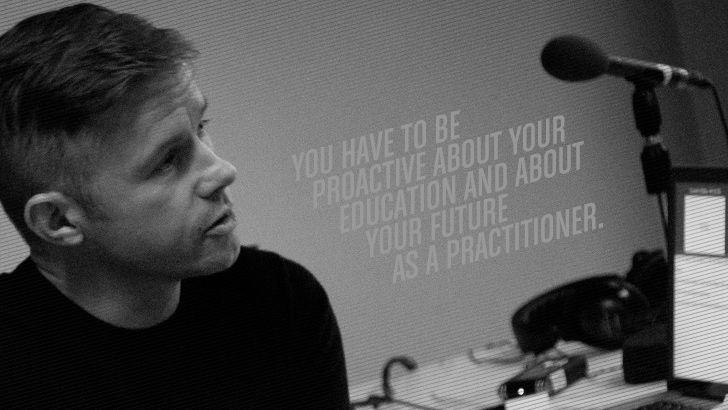 |
||||||||
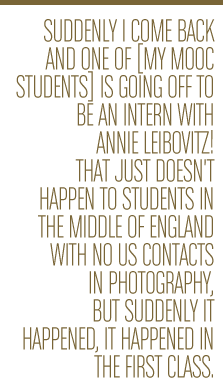 |
A SECOND PARADIGM SHIFTstated: So, how much intervention, if you will, have you had to have with these learning groups? Have you had a situation where you found a group going off in a direction that was problematic? JONATHAN WORTH: No. So far, that hasn’t happened. The only situation in which that would be a problem would be if someone attacked another person that was in the class. That goes against what we’ve explicitly said: feedback has to be constructive. It’s okay to say this or that could be better,” or, “this could be improved if…,” or, “I have a problem with this bit,” as opposed to just trolling. So I would intervene [if someone violated the feedback rule], though, thank goodness I haven’t had to do it yet. On the other hand, if somebody said, “Well, people should always be photographed in black and white,” and somebody else said, “No, people should always be photographed in color,” I’d ask the student to show us what they mean with their work and let the work speak. That’s part of the way that I am looking to teach because I’m very often looking to learn as much as I can from the people who are doing the class. I mean, “Phonar” is a really good example because I don’t think the book has been written yet on what it is to be a 21st-Century photographer. We’re currently going through this photography second paradigm shift and it doesn’t seem that many people are talking about it, let alone doing something constructive to try to understand it, so it would be inappropriate for me to come into that class and say, “Hey, you know what? We’ve all got to consider ourselves publishers because the old business models don’t work and that means that we’ve got to fundamentally rethink what it means to be a digital practitioner.” I think it’s okay to say that we should be thinking about it, but I don’t think it would be right for me to say, “You can’t call yourself a photographer anymore when you use a phone to make images.” I don’t have the answers in either case, but I think what the course, and “Phonar” in particular, is about is working out what the appropriate questions are to be asking and to work those through. So, again, the only time I would intervene is if someone was a bully, not if someone disagreed with me, of course. stated: I was thinking along the lines of the example you just gave, actually. I can see how the groups could be very self-governing… JONATHAN WORTH: Yeah, you and I can, and I think an institution that has sold…that has thought the product was knowledge and they had to hold that knowledge in and parcel it out for a fee, that’s a terrifying thing, because what you’re saying is, you’re empowering [students] to self-organize and not need the institution in order to learn. So, I think yeah, you and I perhaps agree, this is a good thing, but it can be a threatening thing to other people and, it’s exactly the same deal with us as photographers, you know? As an editorial photographer, for example, the old business model that we used to run, we used to rely on being able to control the distribution and the supply of our images. In other words, people would buy magazines and newspapers in order to get access to them. They couldn’t get them otherwise, there was no other way. When the Internet came along and made distribution free and instantaneous, then we sort of thought, “Shit, how can I make a living when someone just gave my product away for free?” And so, people like me, you start thinking about trying to stop it, trying to stop the flow of my images, but it wasn’t until I realized that in fact, actually, you know what, if you think about this as something that can work for you and, in fact, your product wasn’t this restricted supply thing, then suddenly you’re in a really good spot to begin to understand new dynamics and new products that you might have. It’s exactly the same with education. Suddenly, a class that had seven people in the first year has, in its third year, 30,000 people turning up to it. That’s 50% more than the entire population of the university. That’s more, in fact; the same population as NYU. And this has to be good. In fact, the class is now the most oversubscribed in the university. We accept 1 in 10 applicants. So, then suddenly, well hold on a minute, maybe it turns out that our product wasn’t knowledge. Maybe our product, it turns out, was this curated and mentored learning journey. The actual physical experience of being there and being taught and having all this stuff come to you. Then that puts you in a really strong spot and I think that’s really exciting. stated: It’s interesting that you use the word “curated,” which is a word I’ve been thinking about often. If we start to talk about Web 3.0, we might say there’s a strong impulse to curate content, through things like Pinterest and other platforms. Do you see a synergy between the larger tendencies of the web and the success of your courses? JONATHAN WORTH: Absolutely. I mean, I think you’ve hit the nail on the head in things like Pinterest. I think it was Chris Anderson who was one of the first, well certainly one of the first people that I read, who said, with every surplus, there is a shortage. When you get infinite supply of stuff to do, you’re shortage becomes time. So, yeah, you can look at everything on the Internet but you haven’t got time to do that, so we look around for people who can curate an effective journey for us, who can show us/tell us something that is really interesting. I mean it’s one of the things I talk about in “Phonar,” which is key: to become a trusted source. To become someone others can go to believing that you’re going to show them stuff that’s interesting and you’ll be reliable, a trusted source. With regard to education, I think this is one of the key dynamics that’s going to be really useful and I think it’s really interesting right now. If you wanted to do a degree in car design, right? Why would you go to some random university? Why wouldn’t you go to Rolls Royce or, I don’t know, what’s an American brand, say Chevrolet? Why wouldn’t you go and do your degree with Ford? Why would you go to some random university? That’s just crazy. I mean, if I want to study photography, I want to go to the National Portrait Gallery. That’s where I want to learn. I think the next step is that they’re going to be able to validate your academic experience, at which point they become…they’re the curators I want to go to to learn. Does that make sense? stated: Absolutely. I think you’re right that this isn’t something that one typically finds, except maybe in the very top programs where there is a small community of master practitioners. There’s an overabundance of programs and not enough masters, and education is very expensive. That’s one of the remarkable things about “Phonar” and “Picbod.” Clearly there is learning happening at whatever level a student is participating, and it’s happening in an open environment as opposed to the very closed environment of, say, an MFA program. JONATHAN WORTH: I hope so and I think that’s a really key thing. One of the things that we said—Matt Johnston is my partner in the courses and he makes a lot of things happen—we said there should be as few barriers to entry as possible and that means one website that you don’t have to sign into; it means you can get onto it easily and quickly; you shouldn’t have to sign-up for anything; there shouldn’t be any barriers. That also includes the language and the level at which people can engage. I teach students in my class who are dyslexic, a number that don’t have English as their first language, but they all bring a great deal and we would miss out as a community by not having them engaged. So, it’s not just the fact that it’s on the Internet, or the fact that the website doesn’t need to be signed in, or the fact that it’s in understandable English, it’s also that people who haven’t got an academic background can come and still draw something from it because they can bring a great deal, too. Everybody wins. stated: What sort of new things will be happening with the courses moving forward? For example, are you planning to incorporate any new components or new applications of technology? JONATHAN WORTH: I think the way the classes at Coventry are running, is that there will be more open classes, so there will be a class running openly all the time because we’ve seen that this—we as in the photography school, the design school, and the university as a whole—we have seen that this should be a key part of our strategy going forward. So, one of the weaknesses that we see at the minute is that we build up an audience over ten weeks and then they drop off because they want to do something else. So we want to keep something running all of the time. I’ve just written a Masters program, which builds on some of the issues that I picked apart in “Phonar,” but at a Masters level that’s entirely open. I’ve been given the license to rethink how people can get engaged with that. To perhaps answer your question in terms of what I think about the general direction of education, as far as I can see, from my limited history in working with education in the UK, is this: currently lots of universities sort of give you one version of a product to buy. They give you the three-year sign-up, or whatever it is, charge 27,000 pounds for you to come and study, plus your living expenses and so on, which is a daunting thing to sell. What if you can break that down into a series of tiny things, tiny commitments, then people may be more liable to take it up. So with the Masters class, you can do one class—the minimum entry. You can come do it for free, then you can come and do Masters classes over a day or a weekend. You can do one 10-week class over 10 weeks and then each one is 300 pounds for the 10-week class and you can bolt right on over to another class and bolt down to another one and then, if you choose to, you can see it all the way through. So I think that sort of a breaking up of things so that people can kind of—I don’t want to use the word curate again but I’m struggling for another one—people can curate or pool together their own education, their own route through education. That has been something that has been definitely interesting and I think we’ll be exploring it. The other key thing that I think in general is the question of why authoritative institutions or brands are not selling a version of this. Why is Rolls Royce not selling a degree in car design? In engine design? You know? Why is the National Portrait Gallery not doing a degree in photography? I think that is something that’s really exciting and worth exploring. |
|||||||
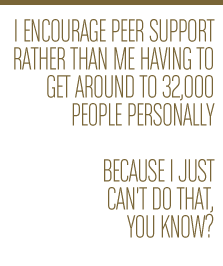 |
TRANSATLANTIC PHOTOGRAPHERstated: I want to talk a bit about your photography. Maybe you can tell us a bit about your transatlantic life and how you have managed to balance working simultaneously in both New York and the UK. JONATHAN WORTH: I started working in the UK, then I worked out of NY, from I think it was ‘97 to 2003 or something like that and then I was based back in the UK, and for a time I would fly backwards and forwards. These days, most of the jobs I do are in the UK for American publications, so I’ll work for The New York Times or whoever. And then I’ll book blocks of time where I’ll go to the US and work for people again there. Actually, when I’m in the US these days, generally I’m working for UK publications, ironically. So that’s kind of how I do that. But at the minute, I’m spending more time building, working out, and applying the things that have worked so well on the classes to people in industry and to people in education who want to do the same things. So that is where I’m spending most of my time in America, and less so taking pictures. Certainly over the last 18 months, it’s been less taking pictures and more talking about and building things around either photography or around Open. stated: And this feels like a natural path for you to follow right now… JONATHAN WORTH: Yes, and I love it. It’s the thing that I spend all my time thinking about and working out. When I began to look at what my products were, I knew that I’ve always been someone to whom people have turned to solve problems creatively and so I guess I’m a problem solver. Each portrait is a problem to be solved, you know? The other thing I would do is, I’ve always pitched stories. I’ve always thought this is really interesting and every week I will pitch stories to magazines and to newspapers and now I think about it and the more photographers that I’ve met via social media, I realize that’s actually not the case for everyone, and I realize that in fact, my value to most of the photo editors and art directors that I’ve worked with is that I would continually pitch ideas to them and I would effectively solve a problem for them. You know, when they wanted stuff, someone to come with ideas, I would be pitching stuff continually. So, when someone comes to me and says, you know what, I have X product and I can’t shift it, I say tell me the story of your product, and it’s the same thing. I mean, naturally I’ll want to tell the story of that product visually and I’ll want to do photo stories on it, but [being able to create and tell stories] has such a wide application… stated: “Visual Problem Solver” is a great way to describe the photographer’s role when working on an assignment. I had a shoot the other day and it turned out the client had an incomplete idea of what they wanted. The planned location was problematic, so I had to go off and wander the neighborhood and find some spots that were going to work visually. JONATHAN WORTH: Exactly! Yeah, you see the world differently. And as far as photography goes, I’ve got this lovely quote from Steve Pyke and he says, “It’s one of the beautiful things about Diane Arbus. You spend some time looking at Diane Arbus images and you walk outside and suddenly everything is a Diane Arbus.” She changes the way you see the world and that’s an amazing thing to be able to do. And then, you’re a person that can look at a 100 different fonts and see exactly which one is right. That’s a gift I’m lacking, but we can walk into a room and I can say, “You know what? The light is great in here, but if we do this, this, and this, then it’s gonna be a lot better;” especially when it eventually manifests itself in print, because I see the world in a different way and that isn’t just visually, you know, I think we all see the world in a different way… Certainly that’s something I’ve been able to plunder with regard to myself as sort of a resource, as an asset, as it were. |
|||||||
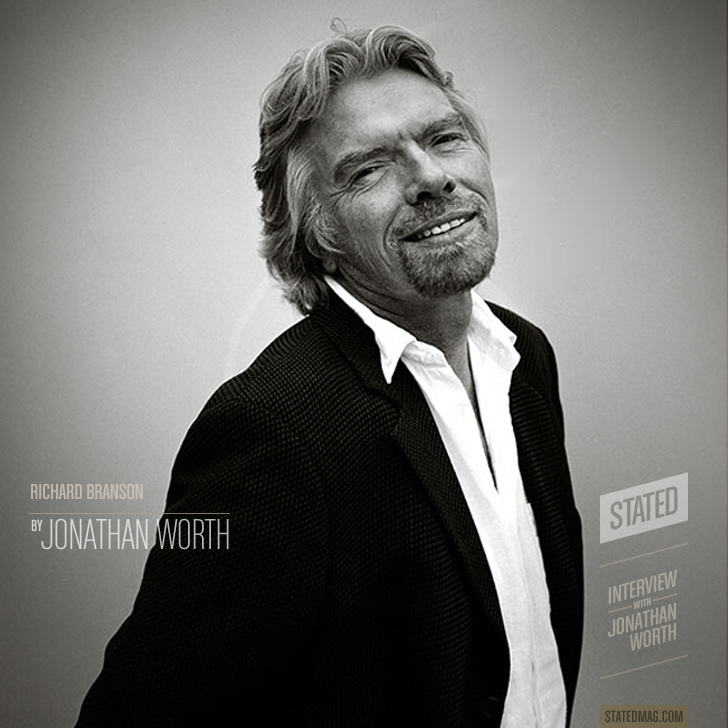 |
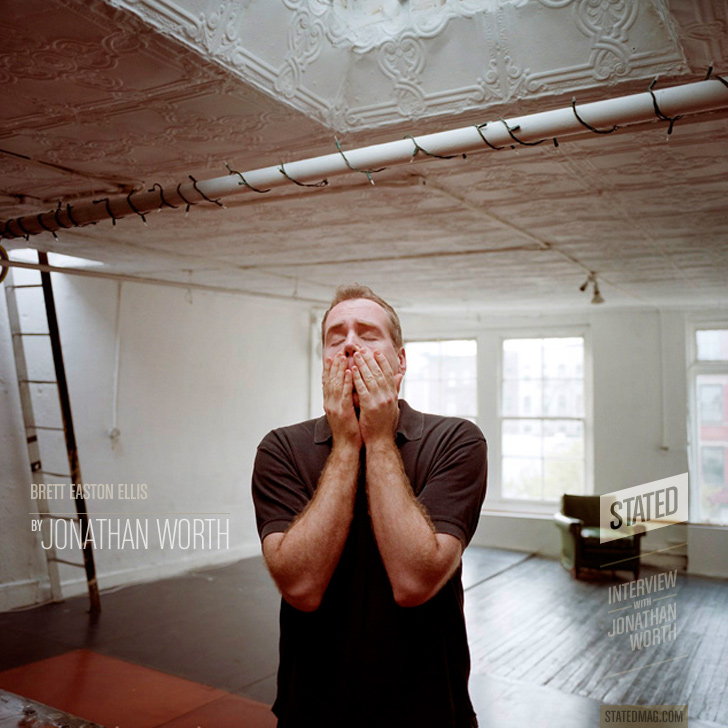 |
|||||||
| (Richard Branson) | (Brett Easton Ellis) | |||||||
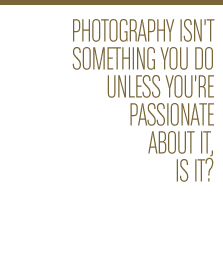 |
PORTRAITUREstated: So, is portraiture your favorite kind of photography to practice? JONATHAN WORTH: Yeah, it is for me. I mean, I love telling stories, but yeah, I’m moved to make images with people. That’s when I’m moved to make images. When I’m with people. It’s seldom inanimate objects, and if it is an inanimate object then it’s because it’s part of a story of a person, that is, you know, a trace of a person. One of my heroes, I think I mentioned a minute ago, is a photographer called Steve Pyke, and I assisted Steve and spent years working with him afterwards as a partner and we are still best friends now, but one of the things he sort of says is that he thinks he sort of documents conversations, and one of the things he does is, he generally shoots an eighth of a second, and it’s that sort of moment when something can still happen; it’s that moment between frames very often. And I think that’s a really beautiful thing and I began to think about how, very often with a portrait, as we know, you have five minutes and you have to get three setups and it has to run landscape, portrait or here, here, and here. That’s when we are really problem solvers, because not only do we have to become intimate, we have to be able to put someone at ease, direct them, and deliver something within an incredible short space of time. But then there are other occasions when you’re not looking for five minutes of intensity, you’re looking to move the subject into a space where the relationship between you is such that you can get something entirely different and yeah, that for me is why I tell stories with pictures. It’s that moment when you share, somebody shares something with you that they haven’t or would be unwilling to share with most people and you talk about it with your pictures. Yeah, for me that means portraiture. stated: With all of the things you have going on these days, do you also find time to work on personal projects? JONATHAN WORTH: Yeah, generally I have at least 3 or 4 that are around and about so that I can drop them and keep them ticking over, but when the open classes are running it just becomes a bit of a time suck because I get into it, you know? Photography isn’t something you do unless you’re passionate about it, is it? And so I think it draws people that are willing to make certain sacrifices because this is what they love. Part of the payment for what we do is the fact that we do it. And so, yeah, the open classes is, umm…I think what I’m trying to get around to saying is that I think it kind of breeds obsessives and people, certainly, that are very passionate about what they do, if not obsessive, and so at the minute, I’m very much thinking about the open classes and openness in general and what those dynamics are and how they manifest themselves and seemingly, at first, unrelated situations. But I do my own stuff and I’m currently doing a piece—I’ve been doing it for the last two years—with a heptathelete called Jessica Ennis, who was, I think up until recently, a sort of world champion, and so I’ve been doing a piece with her. I’ve been doing a piece with a company which sells footwear, and I’m also doing another piece…I came to it because I saw that it had a huge geek following, had people that were really passionately into it, and I wanted to explore just how passionate they were and if I could publish directly to them, rather than having to do it through a newspaper, so I’m doing a piece on them and their hobby, which I’ve been researching and producing for almost a year now and am just starting to shoot. stated: Can you tell us which hobby? JONATHAN WORTH: I will, as soon as I’ve got some stuff banked. I hate keeping secrets, but it could be anything and I think…One of the things I tell my students is, do what you love and if you want to talk to someone and you want to get to work with someone, ask them about what they love and then talk about that. And so this is the same thing. This is a bunch of people that are really passionate about their hobby, it could be anything, and it’s not a hobby that’s mainstream; there is a sort of underground subculture that follows this hobby, and again, this could be anything, anyone could take this advice and run with it. One of the things that I’ve found in the open classes is that people are very often ready to buy into a process before they’re ready to buy into a product, and so by involving them in the process, i.e., the growing and the evolution of the work, then I’m hoping that I can get them to the point where they feel as though they’ve got so much invested in it, they want to see it succeed. I mean, I guess it’s kind of basically what we’re talking about, crowdsourcing, crowdfunding without actually explicitly going on Kickstarter; it’s a bit more organic. It involves going and shaking people’s hands. stated: Well, I hope to see some images from this project as soon as you feel you can show them. JONATHAN WORTH: Oh, blimey! I hope it’s good as well. |
|||||||
|
|
||||||||
|
Visit Jonathan Worth at: |
||||||||










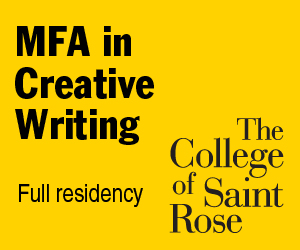
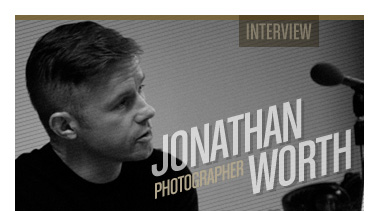
 Thomas V. Hartmann
Thomas V. Hartmann
Reader Comments